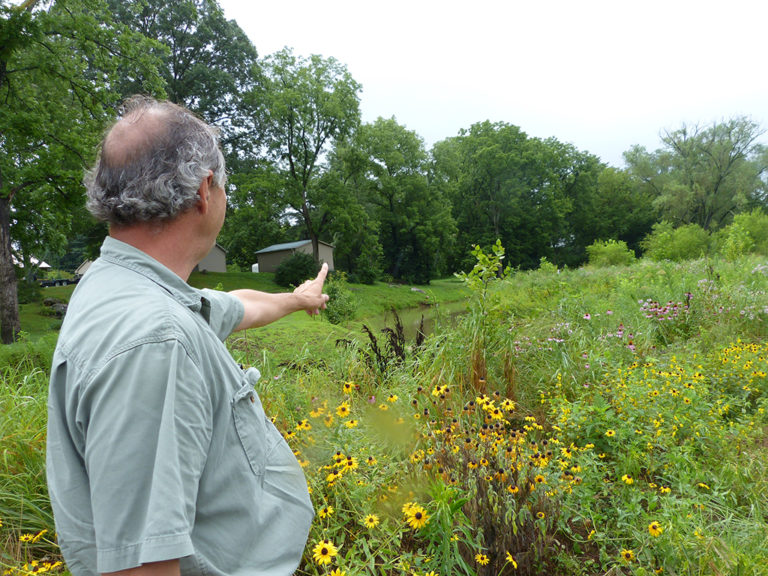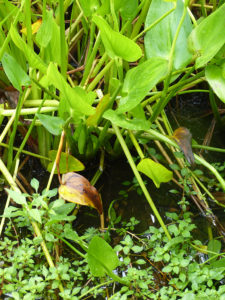Story and Photos by Patricia McDaniels | Featured splash photo by Adam Brimer
Water. It’s a simple chemical compound upon which civilizations have been built and destroyed.
Too little is bad.
Too much is bad.
Just the right amount? That’s a complicated discussion involving the intended use, local topography, changing populations and resource management subject to the whims of government regulation, weather or a changing climate.
The availability of enough water to sustain your needs depends on the happenstance of how your neighbors also use the precious resource—whether it’s the farm next door, the community upstream or the city at the confluence of several watersheds or sitting on a vast aquifer. Few topics raise the ire or concern of landowners, government entities and members of the public like the need for, and right to, clean water.

Across the University of Tennessee system, scientists, Extension specialists and agents and students are examining the rural/urban water interface and what can be done to balance water needs, wants and availability. Engineers, ecologists, soil scientists and even sociologists and anthropologists are involved in discussions about what’s required to best serve society as a whole. The challenge is awareness and use of best management practices by individuals, families, industry and governments.
Within the UT Institute of Agriculture (UTIA), a 10-year effort to remediate the Oostanaula Creek watershed in McMinn County is one example of cooperation to enhance and improve water quality and management. Forbes Walker, a soil scientist with the department of biosystems engineering and soil science (BESS); Lena Beth Reynolds (Knoxville ’79, ’85), an Extension area specialist in McMinn County; and other UTIA faculty have worked with government agencies and people around Athens, Tennessee, to improve water quality in Oostanaula Creek and its flow through the city.
“It’s all about erosion, runoff and sedimentation versus filtration,” Walker says. “We want to encourage water filtration through the ground, which naturally cleanses out pollutants, and reduce or prevent the loss of soil through erosion.”
Walker explains that soil eroding off a farm and water that runs off a street or parking lot after a storm carry pollutants that foul surface waters—a problem for those downstream. It can even contribute to environmental changes in large bodies of water, such as the “Dead Zone” in the Gulf of Mexico, caused by pollutants from runoff draining throughout the Mississippi River watershed.
Walker and Reynolds hosted an Oostanaula Creek watershed tour in June with representatives from the Environmental Protection Agency, the Natural Resources Conservation Service, Tennessee Valley Authority, the Tennessee Department of Agriculture (TDA) and the Tennessee Department of Environment and Conservation. The tour showcased success stories that have contributed to enhancing the watershed for rural and urban users.

The tour began with two farms, a beef cattle operation and a dairy that use the creek for livestock. Based on UTIA research and Extension recommendations, the farmers changed how their livestock access water. For example, pathways were created with fencing and rough-surface concrete to guide cattle to the water rather than allowing them to walk into the creek. The result is less damage to the landscape along the creek bank, which means less erosion.
Also, for cattle farther from the creek, in-pasture water sources such as pumps and troughs were installed, reducing the animals’ treks just to take a drink. The result was healthier, larger cattle—and greater profits for the producers. “We want to develop practices that not only help the environment,” Walker says, “but also make life easier or more profitable for the farmer.”
Downstream were more examples of best management practices in action. The city of Athens had installed a stormwater retention pond to collect drainage that previously flooded neighborhoods. The surrounding area was turned into a public walking trail with interactive exhibits to educate visitors about water management and water usage by plants and wildlife. Athens also is using pervious concrete, grassy lanes and other water management technologies in the construction of sidewalks and parking areas to reduce runoff. A demonstration rain garden in a parking lot encourages residents to be water-wise.
The private and civic cooperation has resulted in better farm management, drier homes and basements (less mold and mildew), fewer public complaints about flooding and lower costs to remediate flooding. What’s more, water flowing into the city’s treatment plant is less costly to clean, and water draining from the Oostanaula into the Hiwassee River (highly valued for its recreational opportunities) carries fewer pollutants downstream.
How to encourage similar efforts was the main question from John McClurkan, an environmental engineer (Knoxville ’99) and administrator of the TDA land and water stewardship section. Blan Dougherty (Knoxville ’79), who owns Eastawood Farm along with his wife, Kathy (Knoxville ’78), said cost sharing from the government is essential. “It’s hard to get individual farmers to carry the financial burden,” he says.
Dougherty also told the tour he initially didn’t believe the water remediation practices would work, but seeing was believing. UTIA faculty are helping others see and believe. Extension agents work regularly with farmers on water-management plans, and researchers continually search for solutions to a myriad of water-related issues.

In one study, Shawn Hawkins (Knoxville ’00, ’05) and Hannah McClellan (Martin ’08, Knoxville ’11), both with BESS, used a soil and water assessment tool to model how incorporating an unfertilized winter wheat cover crop on all the row-crop fields in two West Tennessee watersheds would reduce nitrogen and phosphorus runoffs. Other efforts involve educating farmers on the use of drought-tolerant forages and improving drought tolerance of crops by enhancing the water-holding capacity of soils.

In another study, Walker is leading a $4.9 million effort funded by the U.S. Department of Agriculture to model how changes in temperature, drought patterns and flooding affect land use in the Tennessee and Cumberland river basins.
“The region is experiencing changes in weather patterns and intensities of weather events, be they storms or droughts,” he says. “We’re working to predict ways in which farmers and cities can meet the challenges.”
In its third year, the study is beginning to model how changes in industrial and consumer demand for water will affect its quality and availability for agricultural uses. Project members include Thanos Papanicolaou, a UT Knoxville engineering professor leading the hydrological modeling, and researchers from public and private entities and other colleges and universities across the state.
Of course, the issue of water availability is not limited to Tennessee. Walker expects to apply the model regionally and for some of the information to be applicable to international efforts. Walker and many other UTIA scientists work on agricultural and resource availability projects across the globe.
In 2012, Jennifer DeBruyn, also a faculty member in BESS, joined an international team of scientists assessing sources of harm and routes to recovery of China’s highly polluted and nutrient-enriched Lake Taihu, which serves more than 12 million people. North American lakes are predicted to need such remediation in coming decades. A new effort funded by the National Science Foundation and led by Frank Löffler, a UT-Oak Ridge National Laboratory Governor’s Chair in microbiology and civil and environmental engineering, and Jie Zhuang, a BESS professor, will help scientists from the U.S. and China collaborate on interrelated food, energy and water systems research.
“It’s often difficult to agree on the most important issues we face, but one that we can all agree on is water,” says UTIA Chancellor Tim Cross. “It is critical for our farms, our families and our environment.”
Research can enhance the ability to manage water resources, but getting rural and urban populations to cooperate is the key to the future availability of our most precious resource.
Learn more about how water resources affect your life and what you can do to conserve them at tiny.utk.edu/makingasplash.



